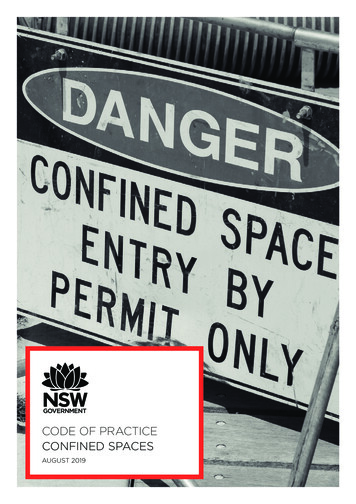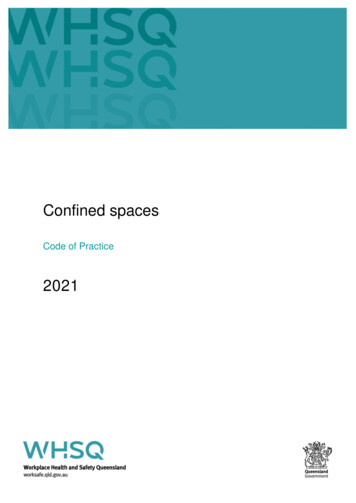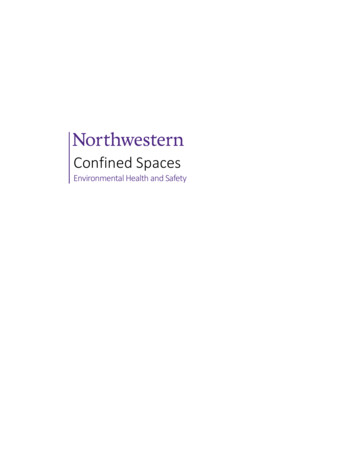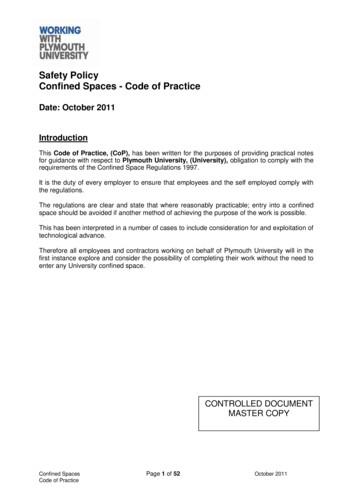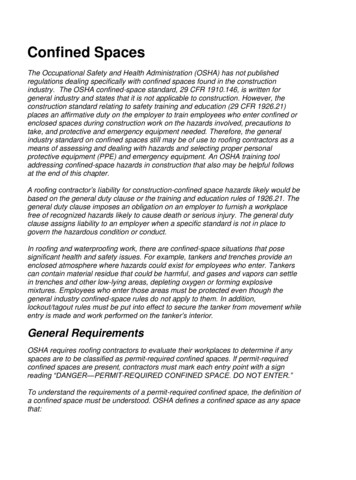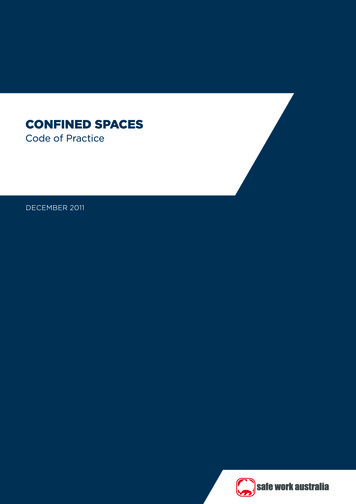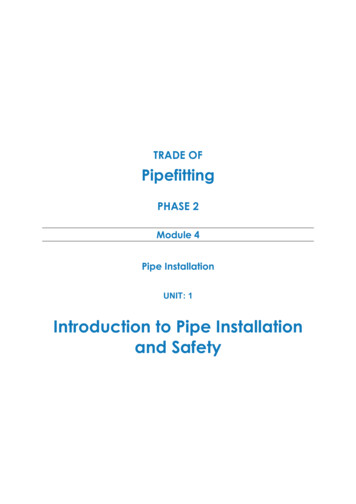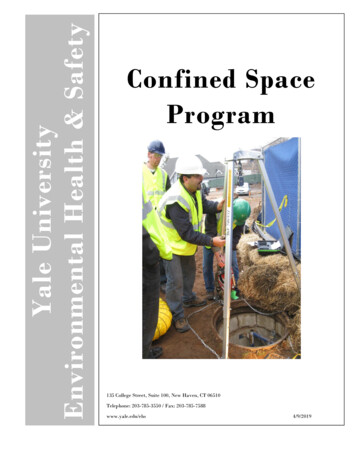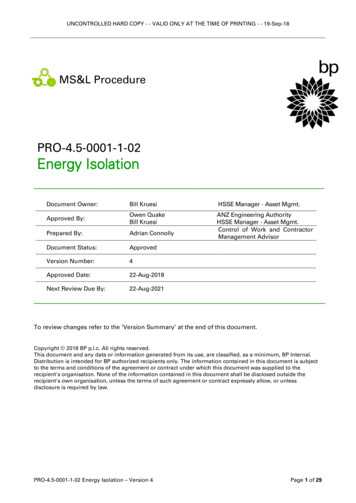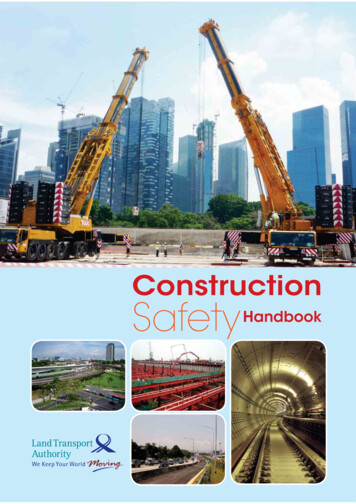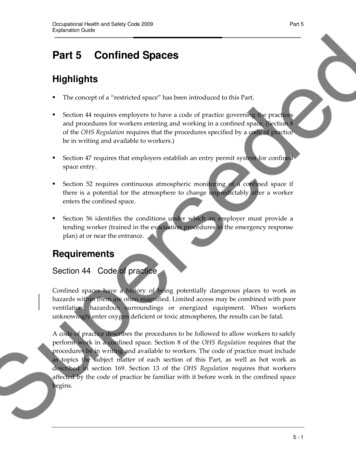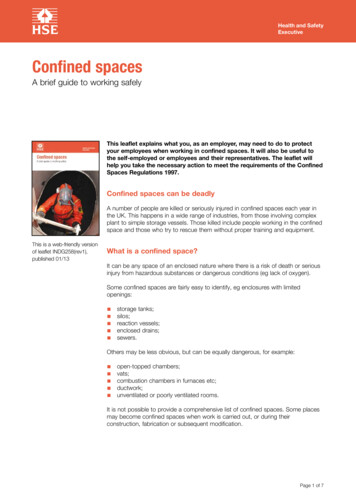
Transcription
Health and SafetyExecutiveConfined spacesA brief guide to working safelyThis leaflet explains what you, as an employer, may need to do to protectyour employees when working in confined spaces. It will also be useful tothe self-employed or employees and their representatives. The leaflet willhelp you take the necessary action to meet the requirements of the ConfinedSpaces Regulations 1997.Confined spaces can be deadlyA number of people are killed or seriously injured in confined spaces each year inthe UK. This happens in a wide range of industries, from those involving complexplant to simple storage vessels. Those killed include people working in the confinedspace and those who try to rescue them without proper training and equipment.This is a web-friendly versionof leaflet INDG258(rev1),published 01/13What is a confined space?It can be any space of an enclosed nature where there is a risk of death or seriousinjury from hazardous substances or dangerous conditions (eg lack of oxygen).Some confined spaces are fairly easy to identify, eg enclosures with limitedopenings: storage tanks;silos;reaction vessels;enclosed drains;sewers.Others may be less obvious, but can be equally dangerous, for example: open-topped chambers;vats;combustion chambers in furnaces etc;ductwork;unventilated or poorly ventilated rooms.It is not possible to provide a comprehensive list of confined spaces. Some placesmay become confined spaces when work is carried out, or during theirconstruction, fabrication or subsequent modification.Page 1 of 7
Health and SafetyExecutiveWhat are the dangers from confined spaces?Dangers can arise in confined spaces because of the following issues. A lack of oxygen.This can occur: where there is a reaction between some soils and the oxygen in theatmosphere; following the action of groundwater on chalk and limestone which canproduce carbon dioxide and displace normal air; in ships’ holds, freight containers, lorries etc as a result of the cargo reactingwith oxygen inside the space; inside steel tanks and vessels when rust forms. Poisonous gas, fume or vapour.These can: build-up in sewers and manholes and in pits connected to the system; enter tanks or vessels from connecting pipes; leak into trenches and pits in contaminated land, such as old refuse tips and old gas works.Liquids and solids which can suddenly fill the space, or release gases into it,when disturbed. Free-flowing solids such as grain can also partially solidify or‘bridge’ in silos, causing blockages which can collapse unexpectedly.Fire and explosions (eg from flammable vapours, excess oxygen etc).Residues left in tanks, vessels etc, or remaining on internal surfaces, which cangive off gas, fume or vapour.Dust present in high concentrations, eg in flour silos.Hot conditions leading to a dangerous increase in body temperature.Some of the above conditions may already be present in the confined space.However, some may arise from the work being carried out, or because of ineffectiveisolation of plant nearby, eg leakage from a pipe connected to the confined space.The enclosure and working space may increase other dangers arising from thework being carried out, for example: machinery being used may require special precautions, such as provision of dust extraction for a portable grinder, or special precautions against electricshock;gas, fume or vapour can arise from welding, or by use of volatile and oftenflammable solvents, adhesives etc;if access to the space is through a restricted entrance, such as a manhole,escape or rescue in an emergency will be more difficult (see Emergencyprocedures).What the law saysYou must carry out a suitable and sufficient assessment of the risks for all workactivities to decide what measures are necessary for safety (under the Managementof Health and Safety at Work Regulations 1999, regulation 3). For work in confinedspaces this means identifying the hazards present, assessing the risks anddetermining what precautions to take. In most cases the assessment will includeconsideration of: the task;the working environment;working materials and tools;the suitability of those carrying out the task;arrangements for emergency rescue.Confined spaces: A brief guide to working safelyPage 2 of 7
Health and SafetyExecutiveHSE’s risk management website will help you further (see Further guidance). Youmay need to appoint competent people to help manage the risks and make surethat employees are adequately trained and instructed (under the Management ofHealth and Safety at Work Regulations 1999, regulation 7). Of course, you may bethe best person to do this, however, you may need to train someone else orengage the services of a competent person for additional help.If your assessment identifies risks of serious injury from work in confined spaces,such as the dangers highlighted above, the Confined Spaces Regulations 1997apply. These regulations contain the following key duties: avoid entry to confined spaces, eg by doing the work from outside; if entry to a confined space is unavoidable, follow a safe system of work; and put in place adequate emergency arrangements before the work starts.These duties, and how to carry them out are described in the sections below.Avoid entering confined spacesYou need to check if the work can be done another way to avoid entry or work inconfined spaces. Better work-planning or a different approach can reduce the needfor confined space working.Ask yourself if the intended work is really necessary, or could you: modify the confined space itself so that entry is not necessary; have the work done from outside, for example: blockages can be cleared in silos by use of remotely operated rotating flaildevices, vibrators or air purgers; inspection, sampling and cleaning operations can often be done from outsidethe space using appropriate equipment and tools; remote cameras can be used for internal inspection of vessels.Safe systems of workIf you cannot avoid entry into a confined space, make sure you have a safe systemfor working inside the space.Use the results of your risk assessment to help identify the precautions you need totake to reduce the risk of injury. These will depend on the nature of the confinedspace, the associated risk and the work involved.Make sure that the safe system of work, including the precautions identified, isdeveloped and put into practice. Everyone involved will need to be properly trainedand instructed to make sure they know what to do and how to do it safely.The following checklist is not intended to be exhaustive, but includes many of theessential elements to help prepare a safe system of work.Appointment of a supervisorSupervisors should be given responsibility to make sure that the necessaryprecautions are taken, to check safety at each stage and may need to remainpresent while work is underway.Confined spaces: A brief guide to working safelyPage 3 of 7
Health and SafetyExecutiveAre people suitable for the work?Do they have sufficient experience of the type of work to be carried out, and whattraining have they received? Where risk assessment highlights exceptionalconstraints as a result of the physical layout, are individuals of suitable build?The competent person may need to consider other factors, eg concerningclaustrophobia or fitness to wear breathing apparatus, and may need to seekmedical advice on an individual’s suitability.IsolationMechanical and electrical isolation of equipment is essential if it could otherwiseoperate, or be operated, inadvertently. If gas, fume or vapour could enter theconfined space, you need to isolate the pipework. In all cases, a check should bemade to ensure isolation is effective.Cleaning before entryThis may be necessary to ensure fumes do not develop from residues etc while thework is done.Check the size of the entranceIs it big enough to allow workers wearing all the necessary equipment to climb inand out easily, and provide ready access and exit in an emergency? For example,the size of the opening may mean choosing air-line breathing apparatus in place ofself-contained equipment which is more bulky and therefore likely to restrict readypassage.Provision of ventilationYou may be able to increase the number of openings and therefore improveventilation. Mechanical ventilation may be needed to make sure there is anadequate supply of fresh air. This is essential where portable gas cylinders anddiesel-fuelled equipment are used inside the space because of the dangers frombuild-up of engine exhaust. Warning: carbon monoxide in the exhaust frompetrol-fuelled engines is so dangerous that use of such equipment in confinedspaces should never be allowed.Testing the airTesting the air may be necessary to check that it is free from both toxic andflammable vapours and that it is fit to breathe. Testing should be carried out by acompetent person using a suitable gas detector which is correctly calibrated.Where the risk assessment indicates that conditions may change, or as a furtherprecaution, continuous monitoring of the air may be needed.Provision of special tools and lightingNon-sparking tools and specially protected lighting are essential where flammable orpotentially explosive atmospheres are likely. In certain confined spaces (eg inside metaltanks) suitable precautions to prevent electric shock include use of extra low voltageequipment (typically less than 25 V) and, where necessary, residual current devices.Confined spaces: A brief guide to working safelyPage 4 of 7
Health and SafetyExecutiveProvision of breathing apparatusBreathing apparatus is essential if the air inside the space cannot be made fit tobreathe because of gas, fume or vapour present, or lack of oxygen. Never try to‘sweeten’ the air in a confined space with oxygen as this can greatly increase therisk of a fire or explosion.Preparation of emergency arrangementsEmergency arrangements will need to cover the necessary equipment, training andpractice drills.Provision of rescue harnessesLifelines attached to harnesses should run back to a point outside the confinedspace.CommunicationsAn adequate communications system is needed to enable communication betweenpeople inside and outside the confined space and to summon help in anemergency.Check how the alarm is raisedDo you need to position someone outside to keep watch and to communicate withanyone inside, raise the alarm quickly in an emergency, and take charge of therescue procedures?Is a ‘permit-to-work’ necessary?A permit-to-work ensures a formal check is undertaken to make sure all theelements of a safe system of work are in place before people are allowed to enteror work in the confined space. It is also a means of communication between sitemanagement, supervisors, and those carrying out the hazardous work. Essentialfeatures of a permit-to-work are: clear identification of who may authorise particular jobs (and any limits to their authority) and who is responsible for specifying the necessary precautions(eg isolation, air testing, emergency arrangements etc);making sure that contractors engaged to carry out work are included;training and instruction in the issue of permits;monitoring and auditing to make sure that the system works as intended.Emergency proceduresWhen things go wrong, people may be exposed to serious and immediate danger.Effective arrangements for raising the alarm and carrying out rescue operations inan emergency are essential.Contingency plans will depend on the nature of the confined space, the risksidentified and consequently the likely nature of an emergency rescue.Emergency arrangements will depend on the risks. You should considercommunications and rescue and resuscitation equipment.Confined spaces: A brief guide to working safelyPage 5 of 7
Health and SafetyExecutiveCommunicationsHow can an emergency be communicated from inside the confined space topeople outside so that rescue procedures can start? Don’t forget night and shiftwork, weekends and times when the premises are closed, eg holidays. Also,consider what might happen and how the alarm can be raised.Rescue and resuscitation equipmentProviding suitable rescue and resuscitation equipment will depend on the likelyemergencies identified. Where such equipment is provided for rescuers to use,training in correct operation is essential.Capabilities of rescuersRescuers need to be properly trained people, sufficiently fit to carry out their task,ready at hand, and capable of using any equipment provided for rescue, egbreathing apparatus, lifelines and fire-fighting equipment. Rescuers also need to beprotected against the cause of the emergency.Shut downIt may be necessary to shut down adjacent plant before attempting emergencyrescue.First-aid proceduresTrained first aiders need to be available to make proper use of any necessary firstaid equipment provided.Local emergency servicesHow are the local emergency services (eg, Fire and Rescue Service) made aware ofan incident? What information about the particular dangers in the confined space isgiven to them on their arrival?The lawThe Confined Spaces Regulations 1997Other legislation may apply, depending on where the confined space is situated oron the task being carried out.Confined spaces within machineryThe Provision and use of Work Equipment Regulations 1998 (PUWER) and theWorkplace (Health, Safety and Welfare) Regulations 1992 apply.Equipment required before entering a confined spaceThe Personal Protective Equipment Regulations 2002 and the Personal ProtectiveEquipment at Work Regulations 1992 (as amended) apply.Confined spaces: A brief guide to working safelyPage 6 of 7
Health and SafetyExecutiveFurther guidanceSafe work in confined spaces. Confined Spaces Regulations 1997. Approved Codeof Practice, Regulations and guidance L101 (Second edition) HSE Books 2009ISBN 978 0 7176 6233 3 www.hse.gov.uk/pubns/books/L101.htmGuidance on permit-to-work systems: A guide for the petroleum, chemical andallied industries HSG250 HSE Books 2005 ISBN 978 0 7176 2943 5www.hse.gov.uk/pubns/books/hsg250.htm. This guidance will be helpful in anyindustry or work activity where the preparation and application of permits-to-workare being considered.HSE’s risk management website: www.hse.gov.uk/riskFurther informationFor information about health and safety, or to report inconsistencies or inaccuraciesin this guidance, visit www.hse.gov.uk/. You can view HSE guidance online andorder priced publications from the website. HSE priced publications are alsoavailable from bookshops.This guidance is issued by the Health and Safety Executive. Following the guidanceis not compulsory, unless specifically stated, and you are free to take other action.But if you do follow the guidance you will normally be doing enough to comply withthe law. Health and safety inspectors seek to secure compliance with the law andmay refer to this guidance.This leaflet is available at www.hse.gov.uk/pubns/indg258.pdf. Crown copyright If you wish to reuse this information visitwww.hse.gov.uk/copyright.htm for details. First published 01/13.Published by the Health and Safety Executive01/13INDG258(rev1)Page 7 of 7
Those killed include people working in the confined space and those who try to rescue them without proper training and equipment. What is a confined space? It can be any space of an enclosed nature where there is a risk of death or serious injury from hazardous substances or dangerous conditions (eg lack of oxygen). Some confined spaces are fairly easy to identify, eg enclosures with limited .
